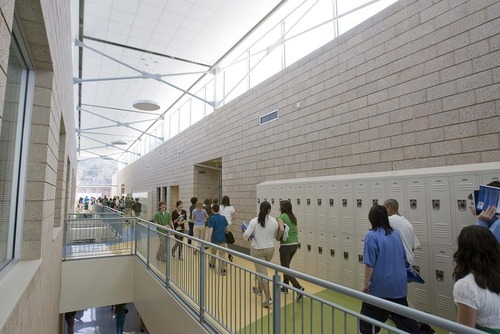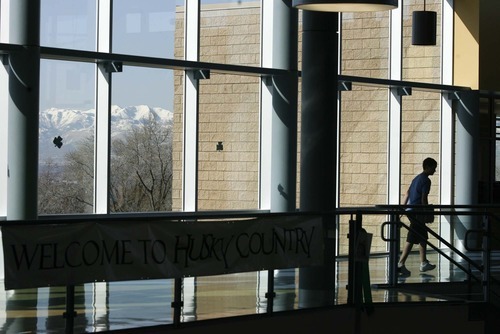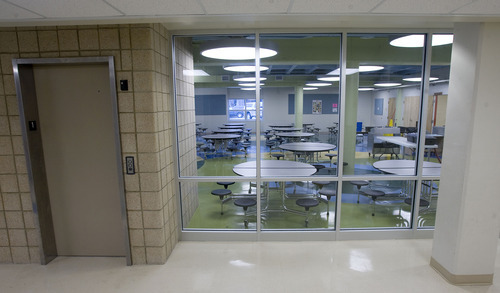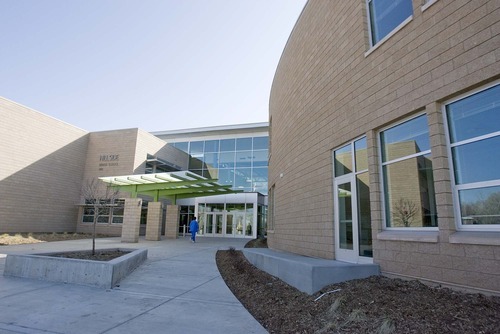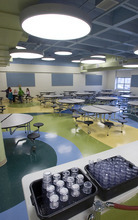This is an archived article that was published on sltrib.com in 2012, and information in the article may be outdated. It is provided only for personal research purposes and may not be reprinted.
Mark Catmull, a counselor at Clayton Middle School in Salt Lake City, likes the natural light and unique design of his school's new building. He also feels better knowing that his daughter, an eighth-grade student, is in a safe place if an earthquake hits.
It's a comforting thought that parents throughout the Salt Lake City School District can share as the district wraps up an effort to make every school earthquake-resistant. Only two projects remain to be done this summer: seismic upgrades at district-sponsored charter schools Open Classroom and Salt Lake Center for Science Education.
Over the past two decades, Salt Lake City School District, which has 36 schools, has spent $401 million on the seismic upgrades, including a $70 million bond in 1993, which rebuilt East High, and a $136 million bond in 1999. Both bonds were approved by voters. Twenty schools were replaced, and 16 schools underwent retrofits.
"Obviously, every child ought to be protected — not just the lucky ones in a new building," said Salt Lake City Superintendent McKell Withers. "There are quite a few school districts along the Wasatch Front that have done what they can to mitigate some of their seismic issues in many of their buildings. But there's nothing quite like being able to bring all of them up to the current seismic code for schools."
Utah does not have a statewide inventory of how many school buildings meet seismic standards, which would help schools withstand a potential 7.0-magnitude quake on the Wasatch Fault.
But a visual survey by engineers last year of a sample of 128 schools found that 77 appeared to fall short of federal risk standards. Thirty-six of those were rated as "high" hazard using a scoring system approved by the Federal Emergency Management Agency.
Rep. Larry Wiley, D-West Valley City, has sponsored legislation the past four years to create a statewide database of the condition of every school, including seismic retrofits. But the price tag — $500,000 — has been an obstacle. Wiley said he or another legislator will run the bill again this year. The database, he said, could be used to help identify which schools need to be rebuilt first, possibly with a matching grant from the state if funds are available.
"Our kids are in school for six to eight hours a day, and a lot of them are in buildings that are unsafe," said Wiley, a former building inspector. "School buildings [also] are a primary location during a disaster. If the schools aren't safe, where do you go?"
Many districts have completed engineering reviews of their own buildings. Canyons School District has identified $650 million in needed improvements. A $250 million bond approved by voters last year will help rebuild several of the district's oldest buildings and renovate others. In Granite, voters approved a $256 million bond in 2009 to improve schools and rebuild Oakwood and Woodstock elementaries and Granger and Olympus high schools, some of the district's oldest schoolhouses.
In districts like Davis that are still growing, it's challenging to address older buildings when new schools are being added, said Brian Turner, director of architectural and construction services in the Davis district. Five years ago, an engineering study identified $115 million in needed construction to address safety issues. About a third of Davis school buildings or additions were rated as "poor" or "very poor." Some of those have retrofitted, Turner said.
But the district also has to open new schools almost every year to keep up with enrollment. This year, the district was expecting 900 new students but received 1,700.
"Right now, we're doing all we can to stay on top of all the new students we get," Turner said. "Until that [growth] goes away, I don't really see us being able to address the seismic issue head-on like some of these other districts are able to do."
Rebuilding old schools would require asking taxpayers for a bond.
Salt Lake City district was slow at first to address the seismic issue, said Jon Dibble, an attorney and parent who pushed the district to spend money on new buildings, starting in the late 1980s. A father of five daughters, he was at a parent-teacher night at East High, sitting in the basement of the four-story brick building, when he wondered what would happen if an earthquake hit at that moment. Survival seemed doubtful.
At first, Dibble said, he was dismissed by some district officials as an "earthquake nut." But after the 1989 San Francisco earthquake damaged the city and collapsed the Oakland bridge — a concrete structure with a design similar to that of Highland High — many more parents rallied behind his cause, precipitating the 1993 school bond.
"It's a remarkable thing that these people [in Salt Lake City district] went out and rebuilt their schools," Dibble said. "Now, if we have a severe earthquake, they'll be havens for the community."
Salt Lake City school improvements
Over the past two decades, Salt Lake City School District has retrofitted or rebuilt every one of its schools to be safe in a big earthquake. Only two projects remain: District-sponsored charter schools Open Classroom and Salt Lake Center for Science Education will be updated this summer.
Schools with new buildings • Backman, Beacon Heights, Bonneville, Dilworth, Escalante, Franklin, Highland Park, Indian Hills, Mountain View, Newman, Nibley Park, North Star, Parkview, Riley, Rose Park, Washington and Whittier elementary schools; Clayton, Glendale, Hillside and Northwest middle schools; East High. (Escalante and North Star were new schools due to neighborhood growth.)


